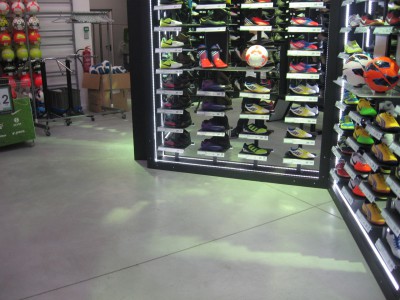Why it’s time to give ‘dry-shake’ a new name
‘Dry-shake’ is a common term in the industrial concrete flooring industry. But is it the best term to use for the product? We believe industrial flooring contractors, and clients, would benefit from thinking different about this product – and from giving it a better name.
Why is it called dry-shake?
The term ‘dry-shake’ stems from a description of the product and how it is applied. Dry-shake is a granular material, which looks like fine coloured sand. It comprises a blend of mineral, metal or synthetic aggregates, cement, a colour pigment, and mixing additives.
Traditionally the blended dry-shake mix is shaken as a dry powder over the surface of fresh concrete – hence the name.
Once on the concrete’s surface, the dry-shake is power trowelled. There it blends with the bleed water and forms a paste, which dries hard and monolithic with the slab, to give a protective layer.
However, referring to the product as ‘dry-shake’ actually misses the point, for two reasons.
1) ‘Dry-shake’ doesn’t properly convey the benefits.
Say ‘dry-shake’ and many industrial flooring contractors will immediately think about steel fibre suppression in a large scale concrete floor. But that’s only one benefit!
A dry-shake hardens the concrete floor’s surface, so it is protected against impact and abrasion damage. This means the life of the floor is greatly extended: in some cases, adding a dry-shake could quadruple the floor’s lifespan.
Given the cost of resurfacing or replacing a floor, that’s a significant saving across the lifetime of a building.
A floor with a dry-shake applied is going to cause fewer repair issues for building owners, or tenants. So building owners will have a more easily rentable space, and could even justify charging a higher rate.
Keeping these benefits clear is vital if flooring contractors and clients are going to fully realise the financial benefits of adding dry-shake to the floor. ‘Dry-shake’ as a name just doesn’t convey what a powerful and lucrative addition to the floor this is!
2) ‘Dry-shake’ doesn’t reflect the application choices.
Sprinkling the dry powder onto the fresh concrete is not the only way to apply it. A very effective alternative is to pre-mix the dry-shake powder with water to create a slurry, and pour the slurry on top of the concrete. This is called ‘wet-on-wet’ application.
There are several advantages to this method. The product is not dependent on the presence of bleed water to be applied effectively. With the dry application method, insufficient bleed water can cause delamination – but this is avoided with wet-on-wet application.
Although wet-on-wet application requires more dry-shake per square metre, so is more expensive, the floor hardness is superior, and the colour density is improved – so the results are impressive both in terms of appearance and lifespan.
In this instance, the name ‘dry-shake’ is again misleading, because it does not accurately describe the product, or the application method!
A new name for concrete dry-shakes
Calling the product ‘dry-shake’ doesn’t reflect the important product benefits. Nor does it accurately describe the variety of ways the product can be applied. That’s why we believe it’s time to use a better term, ‘concrete surface hardener’ – and for further clarity, state the application method (ie, dry-on-wet, wet-on-wet, or even wet-on-dry).
This is how you’ll see us refer to our dry-shake products on this website.




